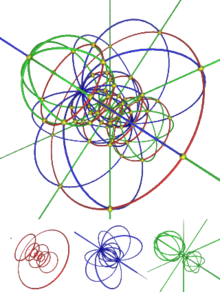n-sphere
The circle is considered 1-dimensional, and the sphere 2-dimensional, because the surfaces themselves are 1- and 2-dimensional respectively, not because they exist as shapes in 1- and 2-dimensional space.Its interior, consisting of all points closer to the center than the radius, is an -sphere is a Riemannian manifold of positive constant curvature, and is orientable.-space with a single adjoined point at infinity; under the metric thereby defined,is the Hodge star operator; see Flanders (1989, §6.1) for a discussion and proof of this formula in the case -dimensional Euclidean space plus a single point representing infinity in all directions.-ball is a line segment whose points have a single coordinate in the interval is related to the volume of the ball by the differential equation Equivalently, representing the unit from above, these recurrences can be used to compute the surface area of any sphere or volume of any ball.-dimensional Euclidean space which is analogous to the spherical coordinate system defined for with:[3][a] Except in the special cases described below, the inverse transformation is unique: where atan2 is the two-argument arctangent function. then the point is one of the poles, zenith or nadir, and the choice of azimuthal angle is arbitrary.)-sphere, is given by The natural choice of an orthogonal basis over the angular coordinates is a product of ultraspherical polynomials, for The standard spherical coordinate system arises from writing may be expressed by taking the ray starting at the origin and passing throughRepeating this decomposition eventually leads to the standard spherical coordinate system.Polyspherical coordinate systems arise from a generalization of this construction. may be written as This can be transformed into a mixed polar–Cartesian coordinate system by writing: HereThe inverse transformation is These splittings may be repeated as long as one of the factors involved has dimension two or greater.The possible polyspherical coordinate systems correspond to binary trees with Each non-leaf node in the tree corresponds to a splitting and determines an angular coordinate.Polyspherical coordinates also have an interpretation in terms of the special orthogonal group.Similarly, the volume measure is Suppose we have a node of the tree that corresponds to the decomposition An alternative given by Marsaglia is to uniformly randomly select a point -ball), and when a point in the ball is obtained scaling it up to the spherical surface by the factor This method becomes very inefficient for higher dimensions, as a vanishingly small fraction of the unit cube is contained in the sphere.In ten dimensions, less than 2% of the cube is filled by the sphere, so that typically more than 50 attempts will be needed.of the cube is filled, meaning typically a trillion quadrillion trials will be needed, far more than a computer could ever carry out.-sphere (e.g., by using Marsaglia's algorithm), one needs only a radius to obtain a point uniformly at random from within the unit This is one of the phenomena leading to the so-called curse of dimensionality that arises in some numerical and other applications.



orthogonal projectionstereographic projectionmeridiansconformalmathematicsdimensionalcirclesphereintegerspherical geometryhypersurfaceEuclidean spacepointsdistanceradiuscenterinteriorline segmentcircumferenceboundarythree-dimensional space3-spherefour-dimensional spaceCartesian coordinate systemunit
n
{\displaystyle n}
-sphereRiemannian manifoldconstant curvatureorientablegeodesicsgreat circlespoint at infinitymetrictopologytopological spacehomeomorphicone-point compactification
n
{\displaystyle n}
-cubesuspensionsimply connectednatural numberpositivereal number1-sphere2-spheremanifoldvolume formHodge star operatorBall (mathematics)closedTopologicallyVolume of an n-ballvolumessurface areasHausdorff measureunit circlegamma function
n
{\displaystyle n}
-cubeshellsspherical coordinate systemvolume elementJacobian matrixLaplace expansionarea elementultraspherical polynomialsspherical harmonicsspecial orthogonal groupbeta functionnormal deviatesn-cubeuniform distributioncurse of dimensionalitydiscrete topologypath-connectedParallelizablecircle groupreal projective lineRiemann spherecomplex projective lineprincipalU(1)-bundleLie groupquaternionic projective linecomplex projective spaceundecidablealmost complex structureoctonionscomplex structureHeinz Hopfquasigroupexotic spheressphere-packingLeech lattice1-normcross-polytopeoctahedrontopological joinConformal geometryExotic sphereHomology sphereHomotopy groups of spheresInversive geometryMöbius transformationpolar coordinatescapital-pi notationempty productStillwell, JohnAgricola, IlkaWeeks, Jeffrey R.Dover PublicationsPrentice HallBibcodeWeisstein, Eric W.MathWorldDimensionVector spaceAffine spaceProjective spaceFree moduleAlgebraic varietySpacetimeLebesgue coveringInductiveHausdorffMinkowskiFractalDegrees of freedom

